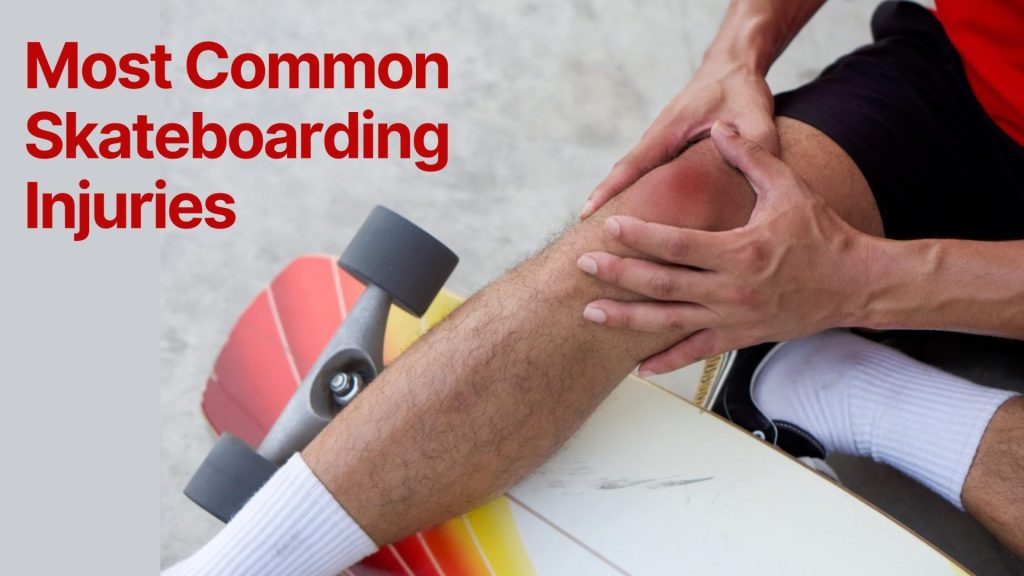Welcome to the thrilling world of skateboarding, where the pavement becomes a canvas and gravity transforms into your greatest ally. The sport has captured the hearts of millions, igniting a passion for tricks, flips, and epic rides – but it can be dangerous!
It’s crucial to acknowledge the potential risks involved if you don’t follow some basic skateboarding safety rules. That’s why here we’ll discuss the most common skateboarding injuries that you should know before stepping on a board.
Every year, thousands of people end up in the emergency room due to skateboarding injuries, ranging from minor cuts and bruises to more serious fractures and head injuries.
According to the National Safety Council, over 245,000 people were treated in hospital emergency rooms in 2021 after being injured while skateboarding (including hoverboards and scooters). Most of these injuries involved young people between the ages of 15 and 24 – they were about 73,000.
The purpose of this article is to inform you about the most common skateboard injuries, and how to prevent them to ride safely and avoid unnecessary pain and suffering.
Contents
Most Common Skateboard Injuries
1. Nose Fractures
Nose fractures are a common injury among skateboarders who take a tumble. When you find yourself face-to-pavement, the impact can result in a fracture of the nose.
Symptoms may include pain, intense swelling, difficulty breathing, and even a comical resemblance to a certain animated reindeer.
Treatment typically involves rest, ice, pain management, and, in severe cases, realignment. Recovery time varies depending on the extent of the fracture. Remember, a good sense of smell is essential for detecting the sweet victory of landing your tricks!
2. Cheek Fractures
Cheek fractures can turn your skateboarding adventure into a cheeky escapade when tricks go wrong. Taking a hard blow to the face can result in fractured cheekbones, resulting in turning your once charming smile into a lopsided expression.
Symptoms include pain, swelling, bruising, and difficulty chewing. Treatment usually involves surgery to realign the fractured bones and promote proper healing.
Remember, it’s always better to keep your cheeks rosy from excitement rather than from a fracture.
3. Knee Injuries
The knees, the unsung heroes of skateboarding. These vital joints bear the brunt of impact and stress during jumps, landings, and hard tricks. Ligament sprains, meniscus tears, and patellar dislocations can turn your skateboarding dreams into a knee-rattling reality.
Treatment may involve physical therapy, rest, and in severe cases, surgical intervention. Protecting your knees with well-fitted knee pads and regularly engaging in strengthening exercises can help safeguard these vital joints and keep you rolling smoothly.
4. Ankle Injuries
A common skateboard injury that affects your lower body is an ankle injury, such as a sprain or fracture. This happens when you twist or roll your ankle while pushing, landing, or turning on your skateboard.
Ankle injuries can cause swelling, bruising, stiffness, and difficulty walking or skating. To prevent ankle injuries, you should wear closed-toe shoes that have slip-resistant soles and provide good ankle support when skateboarding.
You should also warm up before skating, stretch your ankles regularly, and avoid skating on rough or unstable terrain.
5. Lacerations
Lacerations, the battle scars of skateboarding, are badges of honor earned through daring moves and gravity-defying feats. When pushing the boundaries of gravity, occasionally the pavement pushes back. These cuts can range from minor scrapes to deep gashes that may require medical attention.
Cleaning the wound promptly, applying antiseptic, and bandaging it with style can help prevent infections. And for a touch of style, consider getting a skateboard-themed bandage to match your deck.
6. Broken Teeth
Skateboarding and dental work don’t mix well. The clashing of skateboarding and dental work is a painful collision you’d rather avoid.
Impact to the face during a fall or collision can result in chipped or shattered teeth, leaving you with a smile that’s less “pearly whites” and more “skate park chic.”
Treatment may involve dental procedures such as fillings, root canals, or even tooth extractions. To protect your precious pearly whites, consider investing in a quality mouthguard and maintain a smile that dazzles the skate park crowd.
7. Plantar Fasciitis
While not a direct consequence of falls or collisions, plantar fasciitis can creep up on skateboarders due to the repetitive strain on the feet. This condition involves inflammation of the plantar fascia, the tissue connecting the heel to the toes.
Symptoms include heel pain, stiffness, and difficulty with landings. Proper footwear, stretching exercises, and adequate rest can help alleviate the discomfort and keep your feet happy while you conquer the concrete canvas.
8. Head Injuries and Concussions
Head injuries and concussions are the serious side of skateboarding, demanding attention and proper protective measures. The impact of falls or collisions can result in concussions, leading to symptoms such as dizziness, confusion, and an uncontrollable urge to start a skateboarding-themed band.
Immediate medical attention is crucial for diagnosis and monitoring. Wearing a helmet is a non-negotiable safety measure to reduce the risk of head injuries and preserve your brainpower for inventing the next mind-blowing trick.
9. Broken Bones
Broken bones, the rites of passage in the skateboarding realm, often occur when the laws of gravity exert their dominance. Arms, wrists, and collarbones are frequent victims of hard landings and daring stunts.
The treatment depends on the location and severity of the break, ranging from casts to surgical interventions. Remember, bones are meant to provide structure, not an excuse to show off your latest X-ray as a fashion accessory.
10. Sprains and Strains
Sprains and strains can occur when the body twists or stretches beyond its limits during jumps, flips, or rough landings. Ankle sprains and wrist strains are especially common among skateboarders.
Symptoms include pain, swelling, and limited mobility. Initial treatments typically involve rest, ice, compression, and elevation (RICE) therapy to soothe the aches and get you back on your board.
Physical therapy exercises can help regain strength and flexibility in the affected joints.
Remember, proper warm-up exercises and maintaining good form during landings can help prevent these painful setbacks.
11. Contusions (Bruises)
Contusions, also known as bruises, are like skateboarding’s battle scars. These colorful patches of discoloration occur when blood vessels beneath the skin break due to impact.
Bruises can be painful and tender to the touch, serving as a reminder of your fearless tricks and flips.
While contusions may not require specific treatment, they can be tender and painful. Applying ice packs and elevating the affected area can help alleviate discomfort and reduce swelling.
Embrace your contusions as a testament to your skateboarding adventures and wear them with pride.
12. Dislocations
Dislocations can occur when a joint is forced out of its normal position. Skateboarders are no strangers to these joint-wrenching incidents. Ankles, shoulders, and elbows are particularly prone to dislocation.
The resulting pain, swelling, and limited range of motion can make you feel like a human pretzel. Seeking immediate medical attention is crucial for proper realignment and rehabilitation.
Remember, flexibility is a valuable asset on the board, but not when it comes to your joints.
Consequences of Not Taking Proper Safety Measures
Failing to take proper safety measures while skateboarding can have serious consequences. Beyond the physical pain and discomfort of injuries, long-term effects can be far-reaching.
Skateboard accident deaths, though relatively rare, do occur, underscoring the importance of prioritizing safety. Additionally, the financial burden of medical bills and rehabilitation can take a toll on both you and your wallet.
By wearing appropriate protective gear, following safety guidelines, and continuously honing your skills, you can minimize the risk of injuries and keep skateboarding a thrilling and enjoyable experience.
Just starting out with skateboarding? Read a detailed guide on how to skateboard for beginners.
Getting Back to Skateboarding After Injury
So, you’ve taken a spill while skateboarding and found yourself on the sidelines, nursing an injury. It’s time to face the daunting task of getting back on your board and reclaiming your rightful place in the skateboarding realm.
Fear not, I have some sage advice to help you navigate the path to recovery with style and finesse.
Patience, Grasshopper
First and foremost, let’s address the elephant on the halfpipe: patience. As eager as you may be to jump right back into the action, healing takes time.
Rushing the process can lead to re-injury and a prolonged hiatus from the sport you love. Embrace the art of patience, my friend, and trust that your body will mend at its own pace.
Listen to Your Body
Your body is a finely tuned skateboard machine, equipped with its own set of warning signs and signals. Listen closely, and heed what it tells you. Pain? Swelling? Discomfort? These are your body’s way of saying, “Hey, take it easy, buddy!” Respect its wisdom and modify your activities accordingly.
Gradually reintroduce skateboarding, starting with gentle movements and progressing as your body allows.
Start Slow, but Steady
Rome wasn’t built in a day, and your triumphant return to the skate park won’t happen overnight either. Begin with simple, low-impact exercises and movements to reacquaint your muscles and joints with the demands of skateboarding.
Stretching, balance exercises, and light aerobic activities can help rebuild your strength and coordination. Think of it as your personal skateboarding rehabilitation boot camp.
Seek the Guidance of the Skateboarding Gods (aka Professionals)
While you may possess the heart of a skateboarding warrior, it never hurts to enlist the guidance of skateboarding professionals.
Seeking advice from seasoned skateboarders, trainers, or physical therapists can provide invaluable insights and techniques to aid your recovery journey. They’ll have you flipping and grinding with finesse in no time!
Protect Yourself, Always
Remember, prevention is the name of the game. Before launching yourself back into the world of skateboarding, ensure you have the proper protective gear in place. Helmets, knee pads, elbow pads, and wrist guards are your armor against potential mishaps.
Embrace the mantra of “safety first” and let your protective gear become an extension of your skater identity.
Build Mental Resilience
Physical recovery is just one part of the equation. Skateboarding is as much a mental game as it is a physical one. Embrace the setbacks and challenges as opportunities for growth.
Visualize yourself conquering new tricks and landing with effortless grace. Cultivate a positive mindset, and your mental resilience will propel you to new heights of skateboarding glory.
Embrace the Joy of Progress
Every journey begins with a single push, my aspiring skater. Celebrate each milestone along the way, no matter how small. Landing a basic trick, feeling the wind in your hair as you cruise, or simply regaining the confidence to step on the board – these are victories to be cherished.
How Dangerous Is Skateboarding Compared to Other Sports?
Skateboarding, with its high-flying tricks and gravity-defying maneuvers, does have its inherent risks. But here’s the kicker: it’s not the only sport that can get your heart racing and your bones aching. There’s a whole world of sports out there with their own set of perils.
According to the U.S National Safety Council, skateboarding ranks eighth (8th) among the most dangerous sports in the U.S., based on the number of injuries per 100,000 people. The top three positions are taken by football, cycling, and basketball.
Skateboarding Injuries Statistics
The rate of skateboard-related injuries per 10,000 skateboarders is 1,937. This means that for every 10,000 people who skateboard, about 194 of them will get injured in a year. This statistic serves as a stark reminder of the potential risks associated with skateboarding.
However, this does not mean that skateboarding is more dangerous than other sports in terms of injury severity or mortality. In fact, many studies have disproved the danger of skateboarding compared to other sports, citing that many injuries are minor and easily treatable.
There are other sports that involve more serious injuries, such as head injuries and knee and back injuries, that can have long-term consequences for the athletes.
For example, according to a study by PubMed, head trauma accounts for 3.5-13.1% of all skateboarding injuries, while it accounts for 22% of all football injuries. Similarly, knee and back injuries are more common in sports like basketball and soccer than in skateboarding.
Therefore, it is not fair to say that skateboarding is more dangerous than other sports in general. It depends on the type and severity of the injury, as well as the frequency and intensity of the activity.
Wrapping Up
In the exhilarating realm of skateboarding, where gravity defies and asphalt becomes our playground, we have explored the injuries, including broken bones, lacerations, and head-spinning concussions.
But fear not, for knowledge is power, and armed with the right precautions, we can navigate the skateboarding world with confidence and minimize the dangerous risks that come with it.
The most common skateboard injuries, from nose fractures to knee ailments, have been dissected and demystified. We’ve learned their causes, symptoms, treatment options, and the importance of seeking professional medical attention.
But more than that, we’ve uncovered the value of preventive measures and safety gear—helmets, knee pads, and wrist guards—as the shields that protect us on our fearless journey.
So, embrace the fusion of thrill and safety, where the artistry of skateboarding intertwines with the wisdom of precaution. Remember, skateboarding is an expression of freedom and self-discovery, but it’s also a sport that demands respect and mindfulness!
Frequently Asked Questions: (FAQs)
What is the most common skateboarding injury?
The most common skateboarding injury that sends skaters hobbling to the emergency room is none other than a broken wrist. It’s like the “hello” of skateboarding injuries—a rite of passage, if you will. So, protect those wrists and keep your casting adventures for the silver screen!
What are the common injuries in skating?
Apart from the notorious broken wrist, the skateboarding world presents a colorful array of common injuries. From cheek fractures that give you a real “jaw-dropping” experience to lacerations that add an artistic touch to your skin, there’s no shortage of thrilling skateboarding souvenirs.
And let’s not forget the broken teeth, plantar fasciitis, head injuries, and sprains—skateboarding sure knows how to keep us on our toes (or wheels)!
How common are skateboard accidents?
Skateboarding accidents are like unexpected plot twists in the story of skateboarding. While they aren’t an everyday occurrence, they do happen.
Statistics show that thousands of skateboard accidents occur each year, reminding us to stay vigilant and prepared.
How many injuries do skateboarders get?
Skateboarders are no strangers to injuries. Each year, they brave the skate parks, accumulating their fair share of battle scars.
According to the statistics, thousands of skateboarders find themselves seeking medical attention due to injuries. While the exact number may vary, it’s a reminder that skateboarding is not for the faint-hearted.
- Best Electric Skateboard for Big Guys (Heavy Duty E-Boards) - June 3, 2023
- Skateboard Clothing Brands to Make You Stand Out In 2025 - May 31, 2023
- 90s Skateboarding Brands: The Rise and Fall of the Legends - May 28, 2023




![Skateboarding Safety Tips for Beginners and Pros [Safe Ride] skateboarding equipment list and safety tips](https://skateboardgeek.com/wp-content/uploads/2023/05/tips-for-safe-skateboarding-150x150.jpg)




